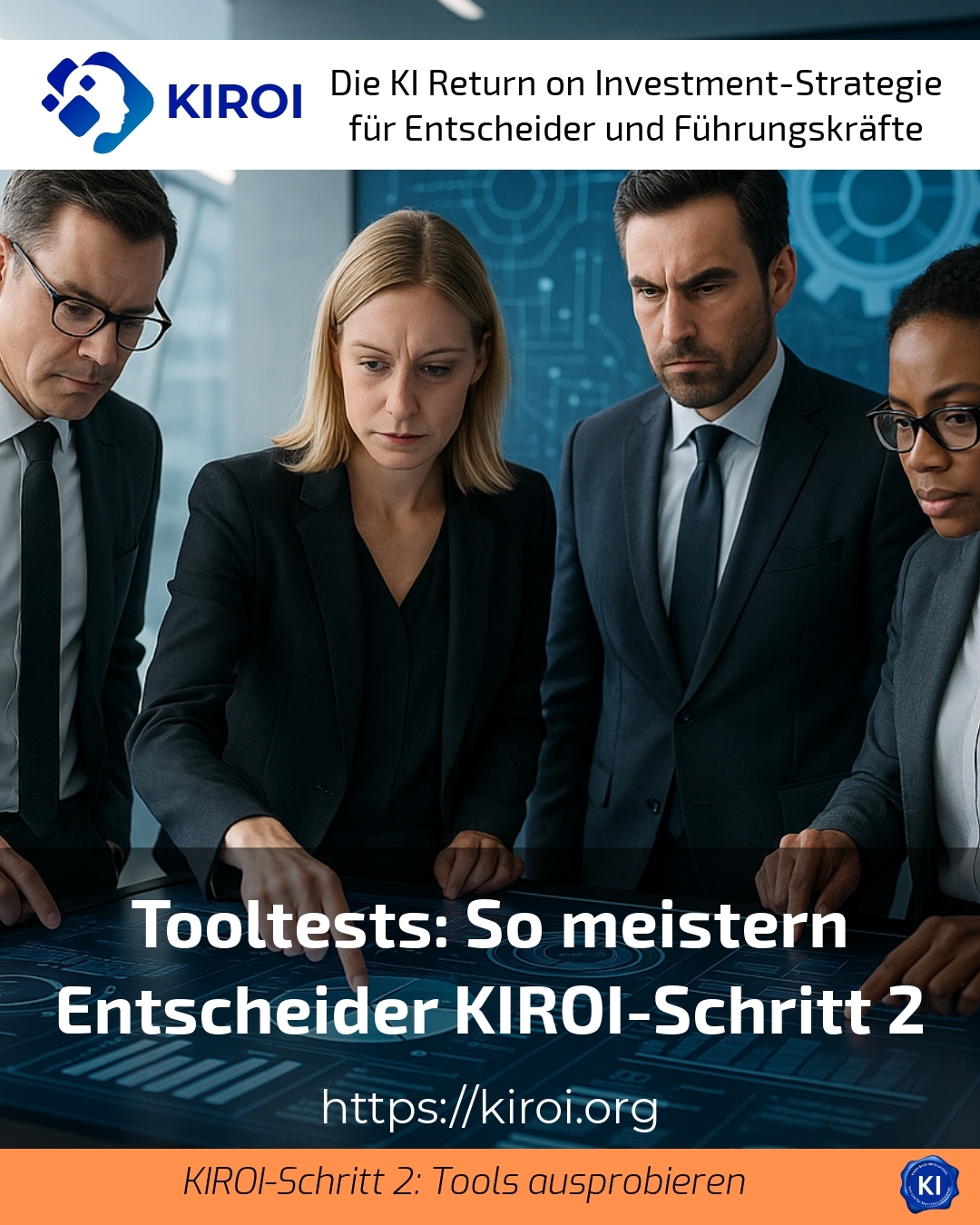Making efficient decisions through systematic tool tests
The selection of suitable tools is crucial in projects involving the implementation of new technologies. Decision-makers are often faced with a large number of solutions that quickly overlap or have different orientations in terms of application. Tool tests are therefore an essential step in identifying and evaluating suitable solutions with a sound overview. KIROI step 2 in particular shows how systematic evaluation can generate clear benefits.
Why tool tests are indispensable for decision-makers
If you want to responsibly introduce new technologies or AI solutions into your company, you need more than just product comparisons. Tool tests offer the opportunity to not only test the tools in terms of their technical functions, but also to evaluate their specific benefits for the respective project. Decision-makers often report uncertainties in the tool jungle, which are clearly reduced with professional support in the testing process. The combination of technical analysis and practical embedding protects against wrong decisions.
In mechanical engineering, for example, tools that not only cover SEO aspects but also enable compliance requirements or performance measurements are in demand. In retail, users are increasingly focussing on tools that offer a comprehensive competitive analysis. Marketing service providers are increasingly using monitoring solutions that provide a holistic picture of their online presence. These industry-specific requirements show how different the expectations of tool tests can be and why a clear focus makes sense.
How decision-makers organise successful tool tests in the course of a project
Effective tool tests start with a thorough inventory: What are the current requirements? Which existing processes should be supported or replaced? This needs analysis forms the framework for selecting specific tools that can be tested. Decision-makers should involve a small team from different departments in order to take different perspectives and needs into account.
A pre-selection can then be made together, which is then tested in detail. It is important to include real use cases from the organisation in order to make statements about practical suitability. An example from the marketing industry shows how a tool test with PageRangers was able to accelerate internal workflows by setting up individual dashboards for SEO performance and realising automatic reporting. This supportive guidance during the test phase enables a goal-orientated decision and a more efficient introduction of the software.
KIROI BEST PRACTICE at company XYZ (name changed due to NDA contract)
A digital marketing agency used tool tests to optimise their SEO processes. By creating personalised dashboards and automated reports, they were able to make workflows more efficient. The well-founded impulses from the support helped to make the introduction safer and more targeted, which increased employee acceptance and reduced sources of error.
Keyword research as the basis for targeted tool evaluations
A central component in the test phase is understanding the search and application intent. Decision-makers can assess specific tools with careful keyword research. For example, SEO tools can be better evaluated if you know whether the goal is information retrieval, transaction or navigation within applications.
In e-commerce, for example, research based on transactional keywords helps to find tools that increase the conversion rate. Service providers tend to focus on informative keywords in order to test holistic monitoring platforms. The combination of keyword research and tool testing therefore ensures data-based, efficient decision-making and prevents wastage.
Support from specialised consultants provides valuable impetus
Many decision-makers report that the tool testing process is supported by external coaching services such as KIROI. This coaching helps companies to penetrate the jungle of offers in a structured way and helps them to navigate projects safely. No promises of salvation are made, but rather impulses are provided and the path to self-determined selection is paved.
KIROI BEST PRACTICE at service provider ABC (name changed due to NDA contract)
In a medium-sized service company, the coaching supported the evaluation of various AI analysis tools. Structured workshops enabled various specialist departments to be involved and their requirements to be clearly identified. The participants reported a much better orientation in the range of tools and a secure feeling when making the final decision.
This support promotes sustainable learning experiences in companies and contributes to the successful implementation of the next steps. The reduction of uncertainties also promotes acceptance of the chosen solutions and ensures a smoother transition to productive use.
My analysis
Tool tests are an essential step that supports decision-makers in finding suitable solutions for their individual requirements. A structured approach, ranging from a well-founded needs analysis to practical test cases, proves to be particularly effective. The interplay of technical evaluation, keyword research and professional support is central to the success of the selection. Experience from a wide range of industries shows that tool tests not only contribute to technical optimisation, but also significantly increase acceptance and efficiency in teams. This lays the foundation for sustainable implementation.
Further links from the text above:
[1] Tool test in KIROI step 2: The best tools for decision-makers
[4] KIROI step 2: Test the best AI tools with keyword research
[2] KIROI Framework - 9 strategic steps and empirical values
For more information and if you have any questions, please contact Contact us on the topic or read more blog posts on the topic Artificial Intelligence Blog here.















